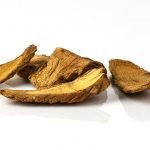Jen Green, ND, FABNO
Dugald Seely, ND, MSc, FABNO
Heather Wright, ND, FABNO
Vis Medicatrix Naturae
When working with cancer patients, naturopathic doctors combine current best evidence, clinical experience, and patient preferences to select natural therapies and lifestyle goals that support outcomes in integrative care. In this way, standard-of-care treatment for cancer is enhanced and patients are treated individually. Utilizing the research tool, KNOWoncology.org, relevant human clinical trials, supportive literature, and clinical pearls can be quickly accessed to help formulate patient treatment protocols. In Part 1, we introduced KNOWoncology.org and showed how to use the clinical tool to find relevant studies in a given area such as lung cancer.
We now present 2 cases of patients with Non-Small Cell Lung Cancer (NSCLC). The cases demonstrate the application of KNOW in clinical practice as well as outcomes via use of naturopathic medicine in integrative care.
Case 1
EA is a 59-year-old male who never smoked. His first consultation for naturopathic care was in February 2016. In November 2015, he reported having an episode of bronchitis with fever, night sweats, and weight loss. He was treated with antibiotics by his internist, and subsequently developed a left leg clot (cancer is a hypercoagulable state). In December 2015, EA was diagnosed with stage IV NSCLC, including multiple, unresectable lung nodules and metastasis to the adrenal gland and bones. He began chemotherapy with carboplatin (platinum chemotherapy) and pemetrexed (anti-folate metabolite). He was switched from heparin to warfarin, and then to enoxaparin sodium to manage his leg clot. He took no other medications except for odansetron for chemotherapy-induced nausea.
As stated in Part 1, the goals of a naturopathic oncology treatment plan include: maintaining weight, improving quality of life, and minimizing dose-limiting side effects (ie, the side effect that require oncologists to reduce or delay treatment). Major goals include improved patient tolerance of treatment and improved survivorship. Dose-limiting side effects in lung cancer can include mucositis, esophagitis, peripheral neuropathy, and bone marrow suppression.
Feb 2016 – May 2016
EA’s enthusiastic and supportive wife wanted to do every therapy she found on “The Truth About Cancer” series and “cancertutor.com,” both of which are unreliable sources of information for cancer patients. Over a series of visits, EA struggled with nausea, anxiety, low appetite, and weight loss from carboplatinum/pemetrexed combination chemotherapy, symptoms that were mitigated by naturopathic medicine. Interestingly, he also developed a 1-day fever after one of his mistletoe injections, which thankfully did not occur during his nadir (the lowest point that an individual’s blood cell count will reach as a side effect of chemotherapy or radiation). The following naturopathic recommendations were made in order of priority:
- Melatonin: 20 mg at bedtime in a formula including magnesium glycinate (200 mg) to support its repletion (Mg can be depleted by platinum chemotherapy1)
- Vitamin D3: 10 000 IU/day for 3 weeks to correct vitamin D deficiency, followed by 5000 IU/day as maintenance2
- Fish oil: 1500 mg EPA/750 mg DHA daily in liquid or capsules
- Astragalus & Ligustrum formula: 3 tabs twice daily, which was changed to Ji Xue formula when his tongue became damp and blood counts dropped
- Cannabis oil nightly to support sleep, with drop-dosing of THC/CBD as needed for nausea during the day
- Boswellia: 500 mg 3 times/day (anti-inflammatory for the lungs) to replace cilantro, Echinacea, and 9-10 other self-prescribed herbs
- Curcumin phytosomal: 500 mg, 2 capsules twice daily5
- Probiotics: 1 cap/day6
- Mistletoe extract injections, switching products at one point, due to US availability
- (As needed): Wheatgrass juice for low RBCs, homeopathic Nux vomica 30C for nausea/anxiety; a Mg-based laxative formula for constipation due to odansetron; vegetarian organic protein drinks to replace standard liquid nutrition; and therapeutic smoothies: 1 scoop whey protein; fat source such as avocado, cashew or almond butter, coconut milk or coconut cream (good source of medium chain triglycerides); organic spinach; organic frozen raspberries/blueberries, pineapple or other fruit).
- Organic soy7 and vegetable soup in daily diet. In a small, controlled trial, daily consumption of vegetable soup increased the median survival time of people with advanced lung cancer by over a year!8
- Recommended to discontinue: Cesium chloride,9 daily oral oregano oil
May 2016 – May 2017
EA’s constipation and anxiety improved over the subsequent year. After 4 months of the carboplatinum/pemetrexed treatment along with supplements and dietary support, EA developed elevated liver enzymes, mild weight loss, and very low WBC; however, his main tumors had shrunk from 8.5 x 6.3 cm to 7.1 x 4.4 cm, and from 53.33 to 31.24 cm. Carboplatinum was discontinued, but he has remained on pemetrexed every 3-4 weeks as maintenance chemotherapy.
A February 2017 nutritional blood and urine analysis suggested need for alpha lipoic acid, Mg, folic acid, and vitamins B2 and B12. He also had low creatinine/protein, high cadmium blood levels (from soldering work), high urine lipid peroxides (indicating oxidative stress), and stool markers suggesting intestinal yeast overgrowth.
Additions to supportive care included the following:
- Silymarin (milk thistle) for elevated liver enzymes and possible prevention of brain metastasis10
- Cordyceps daily to replace Chinese herbal combinations, and for adrenals
- B complex to support B12/folate. Note: In general, we hesitate to upregulate methylation in patients with existing tumor burden because it is not known whether this helps or harms tumor progression. However, pemetrexed is an anti-folate metabolite, and we had just learned from a 2017 study that low pretreatment RBC total folate was associated with an inferior response to pemetrexed-based chemotherapy in stage IV NSCLC.11
- Reduce vitamin D3 to 2500 IU/day, as serum level was 75 ng/mL (187 nmol/L)
- Increase intake of protein, including fish, organic eggs, nuts, seeds
- Resistance exercise to maintain muscle mass
- Berberine: 500 mg twice daily for 1 month for intestinal yeast. Because of concerns about berberine drug interactions with chemotherapy, only short-term use was recommended.
- Alpha lipoic acid: 600 mg starting 4 days after pemetrexed and stopping 2 days before subsequent chemotherapy, to avoid possible interactions (pemetrexed’s half-life is 3.5 hours)
Current Day
EA’s disease remains stable according to a CT scan in May 2017. Pemetrexed is extremely well tolerated now, with only occasional liver enzyme elevation. His weight and WBCs are stable, and he has experienced no nausea or appetite loss. EA’s oncologist is surprised at his tolerance of long-term chemotherapy and his ongoing response to it. It is impossible to know how much of EA’s stability is from chemotherapy versus naturopathic therapy, but his case illustrates how naturopathic oncology can reduce side effects from cytotoxic chemotherapy and optimize outcomes. Consulting with a naturopathic doctor helped redirect EA away from a large list of self-prescribed natural agents of unknown efficacy, toward more tailored, evidence-informed interventions.
Case 2
FD is a 45-year-old male who never smoked and was diagnosed with stage IV lung cancer in September 2014; he had 16 small brain tumors and lytic lesions throughout his spine. His tumors were both ALK- and EGFR-positive, which made him eligible for more than 1 targeted chemotherapy agent. He was given erlotinib – a tyrosine kinase inhibitor that targets EGFR mutations. At the time of consult he was also taking acetaminophen plus hydrocodone and using a fentanyl patch for pain management. His pain manifested as deep bone pain that made him chilly and his teeth chatter. He was constipated from the pain meds and nauseated from slight smells. FD received 10 treatments of whole-brain radiation and palliative radiation to his spine for pain control. He began 150 mg of daily erlotinib, though this dose was reduced to 100 mg due to elevated bilirubin.
Musings on Curcumin
The use of curcumin alongside erlotinib is controversial. In 2014 we believed curcumin should not be used with erlotinib because it is a potential CYP3A4 inducer that could decrease circulating drug levels. This belief was based on a pre-clinical study in rats.12 However, opinions changed in 2016 based on 3 newer studies. The first was a randomized, placebo-controlled, crossover trial in which piperine-enhanced curcuminoids produced no meaningful changes in plasma Cmax, AUC, clearance, elimination half-life, or metabolite levels of the drug probes midazolam, flurbiprofen, or acetaminophen, all of which are metabolized by CYP3A, CYP2C9, and acetaminophen conjugation enzymes.13 As well, both an in-vitro study14 and mouse study15 showed that curcumin enhanced erlotinib’s anti-tumor activity. For this reason, curcumin was not recommended for FD initially; however, since his recurrence in 2016 he has been encouraged to take it.
Initial Naturopathic Plan, Dec 2014:
FD’s initial recommendations included the following:
- Melatonin: 20 mg nightly
- Homeopathic Symphytum 30C and Nux vomica 30C: 2 pellets of each dissolved in mouth 1-3 times daily as needed for pain, nausea, and constipation (note the frequent dosing)
- Vitamin D3: 4000 IU daily
- Hemp-derived CBD oral spray for pain
- Indirect vs direct bilirubin testing and thyroid panel were ordered
- Unflavored prescription medical weight loss/cachexia liquid nutrition formula, vegetarian organic liquid nutrition beverage, and therapeutic smoothies
- Referral to oncology psychologist; guided imagery and journaling
- If rash appears, colloidal oatmeal bath with topical vitamin K3 cream (Note: this was never needed)
- Possible addition of intravenous vitamin C after first CT scan
December 2014 – June 2016
FD had reduced pain, nausea, and constipation using homeopathic treatment and CBD. He slowly reduced his fentanyl patch and his weight stabilized. The lab tests revealed Gilbert’s syndrome – a useful discovery. As a result, FD was advised to avoid fasting, avoid acetaminophen, and to add in S-adenosylmethionine (SAMe) at 400 mg, 2 twice daily, if bilirubin spiked and there was a threat of reducing the effective erlotinib dose. An MRI in February 2015 showed complete remission of brain and lung lesions. Zoledronic acid infusions were added to his conventional plan to prevent pathological bone fractures. FD was stable with no evidence of disease for 18 months. During this time, his fatigue from erlotinib treatment and disease processes resolved and his only side effects were ingrown hairs and ingrown toenails that required minor surgery. In June 2016, FD’s cancer recurred with a skeletal metastasis in the left clavicle (according to PET scan), and he joined a clinical trial in which he received dose-dense radiation to the rib alongside erlotinib.
Naturopathic adjuncts for radiation/erlotinib included the following:
- Continue fish oil, melatonin, vitamin D3, and probiotics
- Curcumin phytosome: 500 mg, 3 caps/day with food
- Astragalus: 500 mg, 2 caps/day
- Water-based relief gel for radiation burn prevention, to be applied twice daily during radiation and afterwards for a few days until skin is recovered
- Ground flaxseeds: 2 tbsp/day during radiation (this was based on mouse studies,16,17 but flaxseed is an excellent fiber/protein and not likely to be harmful)
- Vitamin E (mixed tocopherols and tocotrienols): 400 IU, 2 caps after radiation for 3 months, to prevent radiation fibrosis18,19
Current Day
As of July 2017, FD continues to respond to erlotinib alongside naturopathic interventions. His case illustrates how our decisions can change according to current best evidence. At each point we must weigh potential risks and benefits of natural agents. Cancer management is complex, and accessing current best evidence is vital in decision-making.
Refs:
- Green J, Valero M, Perkowski L. Identifying and Treating Magnesium Deficiency in Cancer Patients Receiving Platinum-based Chemotherapy. Natural Med J. 2015;7(10). Available at: http://www.naturalmedicinejournal.com/journal/2015-10/identifying-and-treating-magnesium-deficiency-cancer-patients-receiving-platinum. Accessed June 20 2016.
- Pilz S, Tomaschitz A, Obermayer-Pietsch B, et al. Epidemiology of vitamin D insufficiency and cancer mortality. Anticancer Res. 2009;29(9):3699-3704.
- Panahi Y, Saadat A, Beiraghdar F, Sahebkar A. Adjuvant therapy with bioavailability-boosted curcuminoids suppresses systemic inflammation and improves quality of life in patients with solid tumors: a randomized double-blind placebo-controlled trial. Phytother Res. 2014;28(10):1461-1467.
- Belcaro G, Hosoi M, Pellegrini L, et al. A controlled study of a lecithinized delivery system of curcumin (Meriva®) to alleviate the adverse effects of cancer treatment. Phytother Res. 2014;28(3):444-450.
- Mehta HJ, Patel V, Sadikot RT. Curcumin and lung cancer-a review. Target Oncol. 2014;9(4):295-310.
- Redman MG, Ward EJ, Phillips RS. The efficacy and safety of probiotics in people with cancer: a systematic review. Ann Oncol. 2014;25(10):1919-1929.
- Wu SH, Liu Z. Soy food consumption and lung cancer risk: a meta-analysis using a common measure across studies. Nutr Cancer. 2013;65(5):625-632.
- Sun AS, Ostadal O, Ryznar G, et al. Phase I/II study of stage III and IV non-small cell lung cancer patients taking a specific dietary supplement. Nutr Cancer. 1999;34(1):62-69.
- Wiens M, Gordon W, Baulcomb D, et al. Cesium-chloride-induced torsades de pointes. Can J Cardiol. 2009;25(9):e329-e331.
- Bosch-Barrera J, Sais E, Cañete N, et al. Response of brain metastasis from lung cancer patients to an oral nutraceutical product containing silibinin. Oncotarget. 2016;7(22):32006-32014.
- Bagley SJ, Vitale S, Zhang S, et al. Pretreatment Red Blood Cell Total Folate Concentration Is Associated With Response to Pemetrexed in Stage IV Nonsquamous Non-Small-cell Lung Cancer. Clin Lung Cancer. 2017;18(2):e143-e149.
- Hsieh YW, Huang CY, Yang SY, et al. Oral intake of curcumin markedly activated CYP 3A4: in vivo and ex-vivo studies. Sci Rep. 2014;4:6587.
- Volak LP, Hanley MJ, Masse G, et al. Effect of an herbal extract containing curcumin and piperine on midazolam, flurbiprofen, and paracetamol (acetaminophen) pharmacokinetics in healthy volunteers. Br J Clin Pharmacol. 2013;75(2):450-462.
- Li S, Liu Z, Zhu F, et al. Curcumin lowers erlotinib resistance in non-small cell lung carcinoma cells with mutated EGF receptor. Oncol Res. 2013;21(3):137-144.
- Yamauchi Y, Izumi Y, Yamamoto J, Normori H. Coadministration of erlotinib and curcumin augmentatively reduces cell viability in lung cancer cells. Phytother Res. 2014;28(5):728-735.
- Christofidou-Solomidou M, Pietrofesa R, Arguiri E, et al. Dietary flaxseed modulates the miRNA profile in irradiated and non-irradiated murine lungs: a novel mechanism of tissue radioprotection by flaxseed. Cancer Biol Ther. 2014;15(7):930-937.
- Christofidou-Solomidou M, Tyagi S, Tan KS, et al. Dietary flaxseed administered post thoracic radiation treatment improves survival and mitigates radiation-induced pneumonopathy in mice. BMC Cancer. 2011;11:269.
- Haddad P, Kalaghchi B, Amouzegar-Hashemi F. Pentoxifylline and vitamin E combination for superficial radiation-induced fibrosis: a phase II clinical trial. Radiother Oncol. 2005;77(3):324-326.
- Delanian S, Porcher R, Rudant J, Lefaix JL. Kinetics of response to long-term treatment combining pentoxifylline and tocopherol in patients with superficial radiation-induced fibrosis. J Clin Oncol. 2005;23(34):8570-8579.
Image Copyright: <a href=’https://www.123rf.com/profile_fotoknips’>fotoknips / 123RF Stock Photo</a>
 Jen Green, ND, FABNO, graduated from CCNM in 2000. In 2008, she founded the Naturopathic Department at Beaumont Hospitals, and was the department head for 5 years. Dr Green has served on various naturopathic boards, including the OAND, CAND, MANP, and the Oncology Association of Naturopathic Physicians. She is currently one of the research directors of KNOW, the Knowledge in Naturopathic Oncology Website. Jen is currently in private practice at Emcura Integrative in Bloomfield Hills, Michigan.
Jen Green, ND, FABNO, graduated from CCNM in 2000. In 2008, she founded the Naturopathic Department at Beaumont Hospitals, and was the department head for 5 years. Dr Green has served on various naturopathic boards, including the OAND, CAND, MANP, and the Oncology Association of Naturopathic Physicians. She is currently one of the research directors of KNOW, the Knowledge in Naturopathic Oncology Website. Jen is currently in private practice at Emcura Integrative in Bloomfield Hills, Michigan.
 Dugald Seely, ND, MSc, FABNO, is a naturopathic doctor, researcher, and administrator who has actively contributed since graduating from CCNM in 2003. Dr Seely serves as the executive director of Research & Clinical Epidemiology at CCNM. He is also the founder and executive director of the Ottawa Integrative Cancer Centre, a Fellow of the American Board of Naturopathic Oncology, and an executive board member for the Oncology Association of Naturopathic Physicians. Dr Seely is a section editor for Integrative Oncology in the journal Current Oncology, has published over 60 peer-reviewed papers, and frequently presents at medical conferences around the world.
Dugald Seely, ND, MSc, FABNO, is a naturopathic doctor, researcher, and administrator who has actively contributed since graduating from CCNM in 2003. Dr Seely serves as the executive director of Research & Clinical Epidemiology at CCNM. He is also the founder and executive director of the Ottawa Integrative Cancer Centre, a Fellow of the American Board of Naturopathic Oncology, and an executive board member for the Oncology Association of Naturopathic Physicians. Dr Seely is a section editor for Integrative Oncology in the journal Current Oncology, has published over 60 peer-reviewed papers, and frequently presents at medical conferences around the world.
 Heather Wright, ND, FABNO, is a naturopathic doctor with 12 years of experience working within hospital-based integrative oncology teams. Dr Wright has specialized in the integrative treatment of pancreatic cancer and has co-authored clinical trials to assess the benefit of natural approaches in this population. She is also a regular contributor to the Natural Medicine Journal and as a speaker provides continuing education to colleagues. She is President of the Oncology Association of Naturopathic Physicians (OncANP.org) and serves as Research Director for KNOWoncology.org, a searchable database of human clinical trials in integrative oncology. Dr Wright currently works at Goodapplewellness.com.
Heather Wright, ND, FABNO, is a naturopathic doctor with 12 years of experience working within hospital-based integrative oncology teams. Dr Wright has specialized in the integrative treatment of pancreatic cancer and has co-authored clinical trials to assess the benefit of natural approaches in this population. She is also a regular contributor to the Natural Medicine Journal and as a speaker provides continuing education to colleagues. She is President of the Oncology Association of Naturopathic Physicians (OncANP.org) and serves as Research Director for KNOWoncology.org, a searchable database of human clinical trials in integrative oncology. Dr Wright currently works at Goodapplewellness.com.





